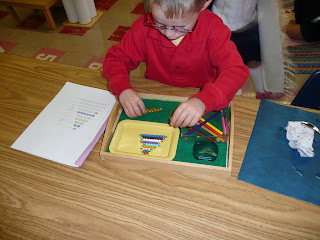 One of the distinguishing aspects of the Montessori method is the "Exercises of Practical Life." Often people wonder why we devote so much attention to such simple activities as pouring water, spooning beans, or grinding coffee. These activities definitely fall into the category of most beloved by the children. Once, on the second day of school, the teacher was greeting the children as they came in the morning. On seeing a little one making her way down the hall, the teacher remarked, "Good morning, are you ready to come in and work?" "I just came for the beans," was the little one's reply. Of course, the child was referring to the activity of pouring beans.
One of the distinguishing aspects of the Montessori method is the "Exercises of Practical Life." Often people wonder why we devote so much attention to such simple activities as pouring water, spooning beans, or grinding coffee. These activities definitely fall into the category of most beloved by the children. Once, on the second day of school, the teacher was greeting the children as they came in the morning. On seeing a little one making her way down the hall, the teacher remarked, "Good morning, are you ready to come in and work?" "I just came for the beans," was the little one's reply. Of course, the child was referring to the activity of pouring beans."A child's work," Dr. Montessori wrote, "is to create the man he will become. An adult works to perfect the environment but a child works to perfect himself." The work the child is doing can only be done by himself. By repetition of motions he is strengthening his muscles, perfecting his coordination and gaining confidence in a particular skill.
 Meaningful work, such as any of our "food work," grinding coffee, cutting bread, cutting celery, or cutting apples, helps the child to develop Independence. The child chooses for himself, what work he will do and when he wants to do it. This freely chosen work is a result of internal motivation.
Meaningful work, such as any of our "food work," grinding coffee, cutting bread, cutting celery, or cutting apples, helps the child to develop Independence. The child chooses for himself, what work he will do and when he wants to do it. This freely chosen work is a result of internal motivation. Wiping up water with a sponge helps the child to perfect her Coordination. The child has to swipe the sponge over the wet areas, decide when its time to squeeze the sponge, hold the sponge over the bucket and squeeze the sponge till it stops dripping, notice when the water is all wiped up, restore all the materials to their original place on the tray, and return the tray without dropping anything to its original position on the shelf.
Wiping up water with a sponge helps the child to perfect her Coordination. The child has to swipe the sponge over the wet areas, decide when its time to squeeze the sponge, hold the sponge over the bucket and squeeze the sponge till it stops dripping, notice when the water is all wiped up, restore all the materials to their original place on the tray, and return the tray without dropping anything to its original position on the shelf.
Carefully pouring water into a narrow necked vase with a funnel lengthens her span of Concentration and develops coordination.
Choosing a task, such as washing windows, and completing it start to finish, concluding with returning the material back to its place on the shelf, neat and ready for the next person, develops a Sense of Order.

Sewing is one of the practical life activities which is most treasured by the children. It helps to develop the small muscles of the hand in preparation for writing, as well as developing all of the above mentioned qualities.

We are currently in need of one or two parents to come in and sit with the children for two to four mornings a month and help with their sewing. If this could be you, please talk to one of the teachers.
To get a link to my photos on Picasa Web Albums, where you can order prints, send me a comment, including your email address, and I will send you an invitation to view my album.










